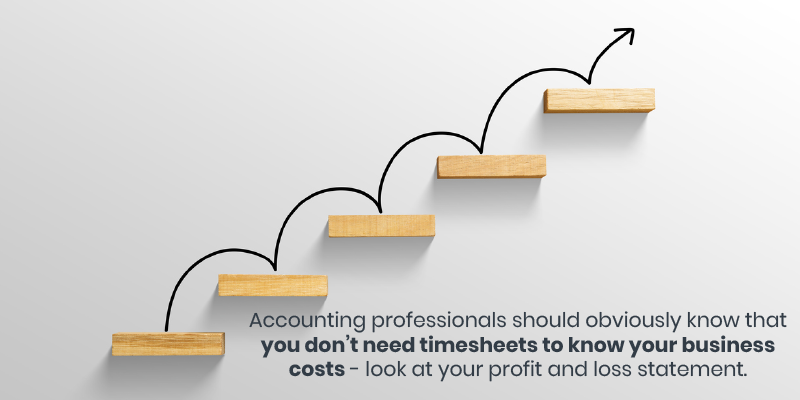Why Billing By The Hour Is Bad
Times, they are a-changin’. Actually, they’ve been a-changin’ for some time, now. Many other industries have caught up, but the accounting and finance world, surprisingly, has been slow to evolve.
Time-based billing has been the dominant billing method for accounting firms for years, and firms are slow to give up this process. But an ever-increasing number of firms are switching to value-based pricing. The world is becoming automated and more efficient than ever. Accountants are able to complete jobs faster, but are earning less revenue per client. Currently, a firm focused solely on the billable hour is one that seemingly continues to struggle in today’s marketplace.
Prior to switching away from billable hours, “It felt as if every other week we were putting dollar signs in front of our clients,” Debbi Warden, CPA, CGMA said of her firm’s previous billing practices. “We are a relationship business. And we didn’t want dollar signs interfering with the relationship.”
What’s Wrong with the Billable Hour?
“The billable hour measures the wrong thing,” said Baker, the founder of VeraSage Institute, a think tank for professional-knowledge firms. He believes that the practice focuses on the practitioner’s inputs (usually time), rather than outputs (quality results). Professional work doesn’t usually fit neatly into billable hours. André Spicer, Professor of organisational behaviour at Cass Business School, illustrates that this means professionals spend a lot of their time trying to make square pegs fit into round holes. They devote a good chunk of their work day recording billable hours rather than doing the work.
Time gets lost just filling out the time tracking sheets, costing firms more money than they’re probably worth. Baker estimates that most firms spend 10% to 25% of their gross revenue on the task. This is complicated by the sheer volume of incoming emails and messages per day. People often deal with a couple hundred emails daily. Most of these interactions take 20-30 seconds. A few require longer responses, using up about five minutes. “If it then takes you three minutes to go into your timesheet program to record the time,” reflects AffinityLive CEO, Geoff McQueen, “you’ve gone from spending 3% of the work unit in administrative overhead to spending 60% in overhead.” And how practical is it, really, to log every second of time you spend answering emails? A report by AffinityLive states, “the timesheet software commonly used is a disconnected afterthought and not part of any other systems people use to get their work done.”
Value Pricing
Value pricing is increasingly becoming the hot topic of discussion at accounting conferences and boardroom tables. It involves setting a fixed price in advance for a service measured by the value it creates for the client. It involves considering the value to the client, not just adding a price to a figured cost (in hours) of providing a service. Dustin Wheeler, CPA at Hawkins in Orem, Utah explains that value pricing thinks of the value to the client, creates the price, and then makes sure that price is justified by the accountant’s cost.
A Leap of Faith
According to The Revolutionary Firm, some people claim that the only way to calculate profitability per customer is with a timesheet. Accounting professionals should obviously know that you don’t need timesheets to know your business costs – look at your profit and loss statement. Don’t confuse costs with cost allocation. David Cristello & Joe Cassandra advise us to remember that price is about a transfer of value, both perceived and actual, in their book, Double Your Accounting Firm.
You should believe that you are worth more to your clients than just your hours. Ron Baker of VeraSage Institute, world-renowned expert on value pricing for CPA firms, wrote “Accountant professionals need to have a value conversation with the customer”, including the best opening statement to begin this conversation: “We will only undertake this engagement if we can agree, to our mutual satisfaction, that the value we are creating is greater than the price we are charging you. Is that acceptable?”.
When the client agrees that the perceived value is greater than the proposed price, they won’t dicker over the cost. Your clients know and understand it. They don’t care how long it takes you to get a project done (within reason!). They want to see results. Shifting towards value billing means that your clients are paying you for outcomes; they’re not paying for how long you spend on a project.
Cristello and Cassandra point out that the market landscape has changed forever. Your clients sign with you, not for your time, but for a partnership. Clients want your knowledge, your advice, your expertise. In their book, they use the example of a plumber:
If a plumber said, “As a free bonus, let me do an audit of your house, I can see where you might be able to add some value,” he would be positioning himself as more valuable and would be able to charge more.
He could add, “I know you’re selling your house soon. There are a few things you can do to add some profit to the bottom line.” Better and better! Value, value, value. No longer is the plumber just a commodity; he is a trusted expert.
This is what your clients are screaming for!
Competition continues to heat up between firms as clients are becoming more cost-wise. They want to be secure in the fact that you are offering value, not just sending invoices for time spent crunching numbers. The firms that will succeed in the future will be the ones that embrace that idea.








